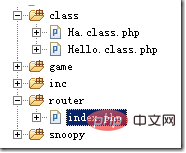PHP에서 URL 라우팅 배포 기능을 구현하는 방법
- coldplay.xixi원래의
- 2020-08-29 14:02:002621검색
PHP가 URL 경로 배포 기능을 구현하는 방법: 먼저 서버 구성에서 [/router/] 경로를 가로채고 경로 배포자를 구현하고 요청된 URI를 얻은 다음 마지막으로 모듈을 작성합니다.

【관련 학습 권장사항: php 그래픽 튜토리얼】
php에서 URL 라우팅 배포 기능을 구현하는 방법:
첫 번째 단계는 서버를 구성하는 것입니다. /router/ 경로/router/路径进行拦截

调用某个文件夹目录下的index.php


특정 폴더 디렉터리의 index.php 페이지를 호출하세요. 이제 모든 모듈이 클래스 디렉터리의 별도 파일에 저장되어 있다고 가정합니다. 아래 그림과 같이 라우터와 동일한 레벨입니다.
<!Doctype html>
<html>
<head>
<title>路由测试~~</title>
<meta http-equiv="content-type" content="text/html; charset=utf-8" />
</head>
<body>
<?php
date_default_timezone_set("Asia/Shanghai");
define("MODULE_DIR", "../class/");
$_DocumentPath = $_SERVER['DOCUMENT_ROOT'];
$_FilePath = __FILE__;
$_RequestUri = $_SERVER['REQUEST_URI'];
$_AppPath = str_replace($_DocumentPath, '', $_FilePath); //==>\router\index.php
$_UrlPath = $_RequestUri; //==>/router/hello/router/a/b/c/d/abc/index.html?id=3&url=http:
$_AppPathArr = explode(DIRECTORY_SEPARATOR, $_AppPath);
/**
* http://192.168.0.33/router/hello/router/a/b/c/d/abc/index.html?id=3&url=http:
*
* /hello/router/a/b/c/d/abc/index.html?id=3&url=http:
*/
for ($i = 0; $i < count($_AppPathArr); $i++) {
$p = $_AppPathArr[$i];
if ($p) {
$_UrlPath = preg_replace('/^\/'.$p.'\//', '/', $_UrlPath, 1);
}
}
$_UrlPath = preg_replace('/^\//', '', $_UrlPath, 1);
$_AppPathArr = explode("/", $_UrlPath);
$_AppPathArr_Count = count($_AppPathArr);
$arr_url = array(
'controller' => 'index',
'method' => 'index',
'parms' => array()
);
$arr_url['controller'] = $_AppPathArr[0];
$arr_url['method'] = $_AppPathArr[1];
if ($_AppPathArr_Count > 2 and $_AppPathArr_Count % 2 != 0) {
die('参数错误');
} else {
for ($i = 2; $i < $_AppPathArr_Count; $i += 2) {
$arr_temp_hash = array(strtolower($_AppPathArr[$i])=>$_AppPathArr[$i + 1]);
$arr_url['parms'] = array_merge($arr_url['parms'], $arr_temp_hash);
}
}
$module_name = $arr_url['controller'];
$module_file = MODULE_DIR.$module_name.'.class.php';
$method_name = $arr_url['method'];
if (file_exists($module_file)) {
include $module_file;
$obj_module = new $module_name();
if (!method_exists($obj_module, $method_name)) {
die("要调用的方法不存在");
} else {
if (is_callable(array($obj_module, $method_name))) {
$obj_module -> $method_name($module_name, $arr_url['parms']);
$obj_module -> printResult();
}
}
} else {
die("定义的模块不存在");
}
?>
</body>
</html>요청한 URI를 가져온 다음 로드할 모듈 이름을 가져옵니다. 그리고 호출 메소드 이름은 uri 매개변수로 간단하게 판단하세요..
세 번째 단계는 모듈을 작성하는 것입니다
위 uri에 따르면 우리가 호출하려는 것은 Hello 모듈 아래의 라우터 메소드이고, 그런 다음 Hello.class.php 파일이라는 파일을 정의할 수 있습니다(Linux에서는 대소문자를 구분합니다)
<?php
class Hello {
private $_name;
private $_varValue;
function __construct() {
}
function router() {
$this->_name = func_get_arg(0);
$this->_varValue = func_get_arg(1);
}
function printResult() {
echo $this->_name;
echo "<p>";
echo var_dump($this->_varValue);
echo "</p>";
}
}
?>마찬가지로 Ha 모듈을 작성할 수 있습니다...관련 학습 추천: 🎜php 프로그래밍🎜(동영상)🎜🎜🎜
위 내용은 PHP에서 URL 라우팅 배포 기능을 구현하는 방법의 상세 내용입니다. 자세한 내용은 PHP 중국어 웹사이트의 기타 관련 기사를 참조하세요!
성명:
본 글의 내용은 네티즌들의 자발적인 기여로 작성되었으며, 저작권은 원저작자에게 있습니다. 본 사이트는 이에 상응하는 법적 책임을 지지 않습니다. 표절이나 침해가 의심되는 콘텐츠를 발견한 경우 admin@php.cn으로 문의하세요.

